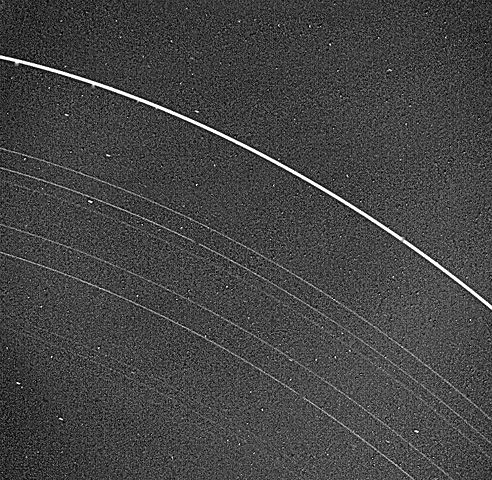 |
This is a file from the Wikimedia Commons. Information from its description page there is shown below.
Commons is a freely licensed media file repository. You can help.
|
Summary
| Description |
English: Voyager 2 picture of Uranus' rings taken on January 22, 1986, from a distance of 2.52 million kilometers. Nine rings are visible in this image, a 15-second exposure through a clear filter. The most prominent and outermost of the nine, called epsilon, is seen at top. The next three in toward Uranus — called delta, gamma and eta — are much fainter and more narrow than the epsilon ring. Then come the beta and alpha rings and finally the innermost grouping, known simply as the 4, 5 and 6 rings. The last three are very faint and are at the limit of detection for the Voyager camera. The bright dots are imperfections on the camera detector. The resolution scale is approximately 50 km (30 mi).
|
| Date |
22 January 1986 |
| Source |
http://photojournal.jpl.nasa.gov/catalog/PIA01977 Originally uploaded to en:wikipedia by Kwamikagami ( talk • contribs), 20:03, 22 December 2005 (UTC) ( log). |
| Author |
NASA |
Permission
( Reusing this file) |
| Public domainPublic domainfalsefalse |
 |
This file is in the public domain because it was solely created by NASA. NASA copyright policy states that "NASA material is not protected by copyright unless noted". (See Template:PD-USGov, NASA copyright policy page or JPL Image Use Policy.) |
|
|
|
Warnings:
- Use of NASA logos, insignia and emblems are restricted per US law 14 CFR 1221.
- The NASA website hosts a large number of images from the Soviet/ Russian space agency, and other non-American space agencies. These are not necessarily in the public domain.
- Materials based on Hubble Space Telescope data may be copyrighted if they are not explicitly produced by the STScI. See also {{ PD-Hubble}} and {{ Cc-Hubble}}.
- The SOHO (ESA & NASA) joint project implies that all materials created by its probe are copyrighted and require permission for commercial non-educational use.
- Images featured on the Astronomy Picture of the Day (APOD) web site may be copyrighted.
|
|
File usage
The following pages on Schools Wikipedia link to this image (list may be incomplete):
SOS Children's Villages chose the best bits of Wikipedia to help you learn. SOS Childrens Villages cares for children who have lost their parents. Our Children's Villages give these children a new home and a new family, while a high-quality education and the best of medical care ensures they will grow up with all they need to succeed in adult life. Have you thought about sponsoring a child?





